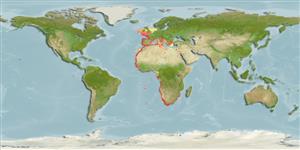Elasmobranchii (tubarões e raias) (sharks and rays) >
Rajiformes (Skates and rays) >
Rajidae (Skates)
Etymology: Rostroraja: Latin, rostrum = beak + Latin, raja, -ae = a sting ray (Ref. 45335).
More on author: Lacepède.
Environment: milieu / climate zone / depth range / distribution range
Ecologia
marinhas demersal; intervalo de profundidade 30 - 600 m (Ref. 6808), usually 50 - 500 m (Ref. 26999). Subtropical; 56°N - 37°S, 19°W - 23°E
Eastern Atlantic and southwest Indian Ocean (British Isles to Mozambique) and the Mediterranean Sea.
Tamanho / Peso / Idade
Maturity: Lm ? range ? - ? cm
Max length : 230 cm TL macho/indeterminado; (Ref. 11284); 202.0 cm TL (female)
Descrição suscinta
Morfologia | Morfometria
A giant skate with a broad-based, abruptly narrow-tipped snout covered with small, sharp thorns; pectoral disc angular, and no thorns on nape or back, but three rows of large thorns on tail (Ref. 5578). Larger immature and adult individuals grey with numerous small white spots above, underside white with no black pores; hatchlings plain reddish-brown above, often with blue spots, and white below with broad dusky grey margins on disc (Ref. 5578).
Inhabit shelf and slope waters (Ref. 4426). Found on sand and rock-sand bottom (Ref. 6808). A bottom-predator of bony fishes, other elasmobranchs, fish offal, crabs, shrimps, mysids, octopi, and cuttlefish (Ref. 5578). Minimum depth reported taken from Ref. 4426. Maximum length for female is 202 cm (Ref. 41333). Oviparous. Distinct pairing with embrace. Young may tend to follow large objects, such as their mother (Ref. 205). Eggs are oblong capsules with stiff pointed horns at the corners deposited in sandy or muddy flats (Ref. 205). Egg capsules are 12.5-18.3 cm long and 10.0-13.9 cm wide (Ref. 41250). About 55-156 eggs are produced per individual annually (Ref. 41250).
Ciclo de vida ou comportamento de acasalamento
Maturidade | Reprodução | Desova | Ovos | Fecundidade | Larvas
Oviparous, paired eggs are laid. Embryos feed solely on yolk (Ref. 50449). Eggs are laid in huge cases and take up to 18 months to hatch (Ref. 5578). Distinct pairing with embrace. Young may tend to follow large objects, such as their mother (Ref. 205).
McEachran, J.D. and K.A. Dunn, 1998. Phylogenetic analysis of skates, a morphologically conservative clade of elasmobranchs (Chondrichthyes: Rajidae). Copeia 1998(2):271-290. (Ref. 27314)
Status na Lista Vermelha da UICN (Ref. 130435)
Ameaça para os humanos
Traumatogenic (Ref. 5578)
Uso pelos humanos
Pescarias: pouco comercial; peixe esportivo: sim
Mais informação
ReferênciasAquaculturaPerfil para aquaculturaEstirpesGenéticaElectrophoresesHereditariedadeDoençasProcessamentoNutrientsConversão de massa
Ferramentas
Relatórios especiais
Baixar XML
Fontes da internet
Estimates based on models
Preferred temperature (Ref.
123201): 8.8 - 17.5, mean 13.5 °C (based on 474 cells).
Índice de diversidade filogenética (Ref.
82804): PD
50 = 1.0000 [Uniqueness, from 0.5 = low to 2.0 = high].
Bayesian length-weight: a=0.00269 (0.00232 - 0.00313), b=3.22 (3.18 - 3.26), in cm total length, based on LWR estimates for this species (Ref.
93245).
Nível Trófico (Ref.
69278): 4.4 ±0.83 se; based on food items.
Resiliência (Ref.
120179): Baixo, tempo mínimo de duplicação da população 4,5 - 14 anos (Fec=55).
Fishing Vulnerability (Ref.
59153): Very high vulnerability (90 of 100).
Nutrients (Ref.
124155): Calcium = 11.3 [2.5, 57.1] mg/100g; Iron = 0.67 [0.17, 1.98] mg/100g; Protein = 17.9 [15.2, 20.5] %; Omega3 = 0.497 [0.171, 1.832] g/100g; Selenium = 34.5 [10.7, 119.7] μg/100g; VitaminA = 9.38 [3.06, 30.12] μg/100g; Zinc = 0.375 [0.184, 0.690] mg/100g (wet weight);
